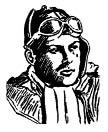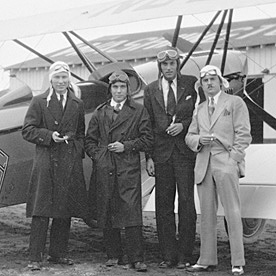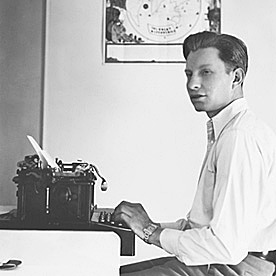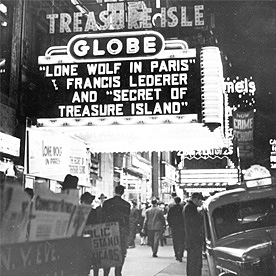Trouble on His Wings (10 page)


Glossary
S
TORIES FROM THE
G
OLDEN
A
GE
reflect the words and expressions used in the 1930s and 1940s, adding unique flavor and authenticity to the tales. While a character's speech may often reflect regional origins, it also can convey attitudes common in the day. So that readers can better grasp such cultural and historical terms, uncommon words or expressions of the era, the following glossary has been provided.
Albany night
boat:
one of a large number of river steamers formerly common to the
Hudson River and patronized by New York City residents, vacationers and
newlyweds.
â to text
amphibian:
an airplane
designed for taking off from and landing on both land and water.
â to text
Amur:
Amur River, the
world's ninth longest river that forms the border between northeastern
China (Manchuria) and the Russian Far East (between Siberia and the
Pacific Ocean). It was an area of conflict during the war between China
and Japan that began in 1937, and eventually led to World War II in the
Pacific.
â to text
astern:
in a position
behind a specified vessel.
â to text
ballyhoo:
to advertise or publicize noisily or blatantly.
â to text
Black Hills:
a small isolated
mountain range in western South Dakota and extending into Wyoming. The
Black Hills are home to the tallest peaks in continental North America east of
the Rocky Mountains.
â to text
bull:
a gross blunder.
â to text
bumboat:
a boat used in
peddling provisions and small wares among vessels lying in port or offshore.
â to text
bung starter:
a wooden mallet
used for tapping on the bung (cork or stopper) to loosen it from a barrel.
â to text
cabin job:
an airplane that
has an enclosed section where passengers can sit or cargo is stored.
â to text
castellated
clouds:
cloud formation named for its tower-like projections that billow
upwards from the base of the cloud.Â
â to text
China Clipper:
one of three Martin
M-130 flying boats designed and built by the Glenn L. Martin Company for Pan
American Airways in the 1930s. The planes, called Clippers and named
for the swift square-rigged sailing ships of the 1800s, were designed to
take off and land on water and possessed long-range flying capabilities.
The China Clipper started flying passengers in
1936 from San Francisco to Manila making the 8,050-mile
(13,683-km) trip in 60 hours of actual flying time spanning five days with
stopovers in Hawaii, Midway Island, Wake Island, Guam and Manila.Â
â to text
Coeur d'Alene:
city located in
northern Idaho, on the northern shore of the Coeur d'Alene Lake and the western
edge of the Coeur d'Alene National Forest. The city is named for the Coeur
d'Alene tribe of Native Americans, a name given them by the French traders
meaning “heart of awl,” or “sharp-hearted” out of respect for their tough
trading practices.
â to text
crown fire:
a fire that
crowns
(spreads to the top branches of trees) and can spread at an incredible pace
through the top of a forest. Crown fires can be extremely dangerous to all
inhabitants underneath, as they may spread faster than they can be outrun,
particularly on windy days.
â to text
davits:
any of various
cranelike devices, used singly or in pairs, for supporting, raising and lowering
boats, anchors and cargo over a hatchway or side of a ship.
â to text
DeVry:
manufacturer of 35mm and 16mm movie cameras popular in the 1930s,
especially with newsreel cameramen.
â to text
flying boat:
a seaplane whose main body is a hull adapted for floating.
â to text
foredeck:
the forward part of a boat's main deck.
â to text
Frisco:
San Francisco.
â to text
gig:
a boat reserved for the use of the captain of a ship.
â to text
G-men:
government men; agents of the Federal Bureau of Investigation.
â to text
gow up:
to make sticky or mess something up. From
gow,
meaning opium
or sap; the sticky brown resin harvested from poppies. Used figuratively.
â to text
gumbo:
soil that turns very sticky and muddy when it becomes wet; found
throughout the central US.
â to text
gunwale:
the upper edge of the side of a boat. Originally a gunwale was a
platform where guns were mounted, and was designed to accommodate the
additional stresses imposed by the artillery being used.
â to text
Han River:
a river, about 700 miles long (1,126 km), of east central China
flowing generally southeast to the Yangtze River.
â to text
Jonah:
one who is
believed to bring bad luck or misfortune; also called a jinx. The name
originated from the Old Testament prophet,
Jonah,
who by disobeying
God's command caused a storm to endanger the ship he was traveling in.Â
â to text
kite:
an airplane.
â to text
lampblack:
a black pigment made from soot.
â to text
Lord
Chesterfield:
English politician and writer best
known for
Letters to His Son
(1774), which portrays the ideal
eighteenth-century gentleman.
â to text
man-o'-war:
any armed ship of a national navy, usually carrying between 20 and
120 guns.
â to text
Medusa:
(Greek mythology) monster with live venomous snakes for hair;
people who looked at her would turn to stone. A hero, Perseus, was able to kill
Medusa, aiming his sword by looking at her reflection in a highly polished
shield, and then cutting off her head.
â to text
Nakajima:
the name for the aircraft produced by the Nakajima Aircraft
Company, Japan's first aircraft manufacturer, founded in 1917.
â to text
newshawk:
a newspaper reporter, especially one who is energetic and
aggressive.
â to text
painter:
a rope, usually at the bow, for fastening a boat to a ship, stake,
etc.
â to text
Perseus:
(Greek mythology) hero who killed Medusa. The god Hermes and
goddess Athena helped him in this brave deed by giving him winged shoes, a
magical sword and a polished shield. With the help of these, he swooped down on
Medusa from the air, used the shield as a mirror, and cut off her head without
looking at her directlyâas anyone who looked at her turned to stone.
â to text
Rising Sun:
Japan; the characters that make up Japan's name mean “the sun's
origin,” which is why Japan is sometimes identified as the “Land of the Rising
Sun.” It is also the military flag of Japan and was used as the ensign of the
Imperial Japanese Navy and the war flag of the Imperial Japanese Army until the
end of World War II.
â to text
Scheherazade:
the female narrator of
The Arabian Nights,
who during one
thousand and one adventurous nights saved her life by entertaining her husband,
the king, with stories.
â to text
sculling oar:
a single oar that is moved from side to side at the stern of a boat
to propel it forward.
â to text
siege guns:
heavy guns for siege operations, used to overcome the target with
bombardment. (A
siege
is a military operation in which an army surrounds
a fortified place and isolates it while continuing to attack.)
â to text
slipped:
caused (a descending parachute) to glide in a particular direction
by pulling down on suspension lines on the side toward the desired direction so
as to spill air out of the opposite side of the canopy.
â to text
slipstream:
the airstream pushed back by a revolving aircraft propeller.
â to text
smeared:
smashed.
â to text
snap-brim:
a felt hat with a dented crown, and the brim turned up in back and
down in front.
â to text
SS:
steamship.
â to text
stall:
a situation in which an aircraft suddenly dives because the airflow
is obstructed and lift is lost. The loss of airflow can be caused by
insufficient airspeed or by an excessive angle of an airfoil (part of an
aircraft's surface that provides lift or control) when the aircraft is
climbing.
â to text
struts:
supports for a structure such as an aircraft wing, roof or bridge.
â to text
tarmac:
airport runway.
â to text
tracer:
a bullet or shell whose course is made visible by a trail of flames
or smoke, used to assist in aiming.
â to text
volplaning:
gliding toward the earth in an airplane, with no motor power or
with the power shut off.
â to text
L. Ron Hubbard in the
Golden Age of
Pulp Fiction
I
n writing an adventure story
a writer has to know that he is adventuring
for a lot of people who cannot.
The writer has to take them here and there
about the globe and show them
excitement and love and realism.
As long as that writer is living the part of an
adventurer when he is hammering
the keys, he is succeeding with his story.
Adventuring is a state of mind.
If you adventure through life, you have a
good chance to be a success on paper.
Adventure doesn't mean globe-trotting,
exactly, and it doesn't mean great deeds.
Adventuring is like art.
You have to live it to make it real.
â L. Ron Hubbard
L. Ron Hubbard
and American
Pulp Fiction
B
ORN
March 13, 1911, L. Ron Hubbard lived a life at least as expansive as the stories with which he enthralled a hundred million readers through a fifty-year career.
Originally hailing from Tilden, Nebraska, he spent his formative years in a classically rugged Montana, replete with the cowpunchers, lawmen and desperadoes who would later people his Wild West adventures. And lest anyone imagine those adventures were drawn from vicarious experience, he was not only breaking broncs at a tender age, he was also among the few whites ever admitted into Blackfoot society as a bona fide blood brother. While if only to round out an otherwise rough and tumble youth, his mother was that rarity of her timeâa thoroughly educated womanâwho introduced her son to the classics of Occidental literature even before his seventh birthday.
But as any dedicated L. Ron Hubbard reader will attest, his world extended far beyond Montana. In point of fact, and as the son of a United States naval officer, by the age of eighteen he had traveled over a quarter of a million miles. Included therein were three Pacific crossings to a then still mysterious Asia, where he ran with the likes of Her British Majesty's agent-in-place for North China, and the last in the line of Royal Magicians from the court of Kublai Khan. For the record, L.RonHubbard was also among the first Westerners to gain admittance to forbidden Tibetan monasteries below Manchuria, and his photographs of China's Great Wall long graced American geography texts.
Upon his return to the United States and a hasty completion of his interrupted high school education, the young Ron Hubbard entered George Washington University. There, as fans of his aerial adventures may have heard, he earned his wings as a pioneering barnstormer at the dawn of American aviation. He also earned a place in free-flight record books for the longest sustained flight above Chicago. Moreover, as a roving reporter for
Sportsman Pilot
(featuring his first professionally penned articles), he further helped inspire a generation of pilots who would take America to world airpower.

L. Ron Hubbard, left, at Congressional Airport, Washington, DC, 1931, with members of George Washington University flying club.
Immediately beyond his sophomore year, Ron embarked on the first of his famed ethnological expeditions, initially to then untrammeled Caribbean shores (descriptions of which would later fill a whole series of West Indies mystery-thrillers). That the Puerto Rican interior would also figure into the future of Ron Hubbard stories was likewise no accident. For in addition to cultural studies of the island, a 1932â33 LRH expedition is rightly remembered as conducting the first complete mineralogical survey of a Puerto Rico under United States jurisdiction.
There was many another adventure along this vein: As a lifetime member of the famed Explorers Club, L.RonHubbard charted North Pacific waters with the first shipboard radio direction finder, and so pioneered a long-range navigation system universally employed until the late twentieth century. While not to put too fine an edge on it, he also held a rare Master Mariner's license to pilot any vessel, of any tonnage in any ocean.

Capt. L. Ron Hubbard in Ketchikan, Alaska, 1940, on his Alaskan Radio Experimental Expedition, the first of three voyages conducted under the Explorers Club Flag.
Yet lest we stray too far afield, there is an LRH note at this juncture in his saga, and it reads in part:
“I started out writing for the pulps, writing the best I knew, writing for every mag on the stands, slanting as well as I could.”
To which one might add: His earliest submissions date from the summer of 1934, and included tales drawn from true-to-life Asian adventures, with characters roughly modeled on British/American intelligence operatives he had known in Shanghai. His early Westerns were similarly peppered with details drawn from personal experience. Although therein lay a first hard lesson from the often cruel world of the pulps. His first Westerns were soundly rejected as lacking the authenticity of a Max Brand yarn (aparticularly frustrating comment given L.RonHubbard's Westerns came straight from his Montana homeland, while Max Brand was a mediocre New York poet named Frederick Schiller Faust, who turned out implausible six-shooter tales from the terrace of an Italian villa).
Nevertheless, and needless to say, L.RonHubbard persevered and soon earned a reputation as among the most publishable names in pulp fiction, with a ninety percent placement rate of first-draft manuscripts. He was also among the most prolific, averaging between seventy and a hundred thousand words a month. Hence the rumors that L.RonHubbard had redesigned a typewriter for faster keyboard action and pounded out manuscripts on a continuous roll of butcher paper to save the precious seconds it took to insert a single sheet of paper into manual typewriters of the day.

L. Ron Hubbard, circa 1930, at the outset of a literary career that would span half a century.
That all L. Ron Hubbard stories did not run beneath said byline is yet another aspect of pulp fiction lore. That is, as publishers periodically rejected manuscripts from top-drawer authors if only to avoid paying top dollar, L. Ron Hubbard and company just as frequently replied with submissions under various pseudonyms. In Ron's case, the list included: Rene Lafayette, Captain Charles Gordon, Lt. Scott Morgan and the notorious Kurt von Rachenâsupposedly on the lam for a murder rap, while hammering out two-fisted prose in Argentina. The point: While L.Ron Hubbard as Ken Martin spun stories of Southeast Asian intrigue, LRH as Barry Randolph authored tales of romance on the Western rangeâwhich, stretching between a dozen genres is how he came to stand among the two hundred elite authors providing close to a million tales through the glory days of American Pulp Fiction.

A Man of Many Names
Between 1934 and 1950, L. Ron Hubbard authored more than fifteen million words of fiction in more than two hundred classic publications.
To supply his fans and editors with stories across an array of genres and pulp titles, he adopted fifteen pseudonyms in addition to his already renowned L. Ron Hubbard byline.
______
Winchester Remington Colt
Lt. Jonathan Daly
Capt. Charles Gordon
Capt. L. Ron Hubbard
Bernard Hubbel
Michael Keith
Rene Lafayette
Legionnaire 148
Legionnaire 14830
Ken Martin
Scott Morgan
Lt. Scott Morgan
Kurt von Rachen
Barry Randolph
Capt. Humbert Reynolds

In evidence of exactly that, by 1936 L. Ron Hubbard was literally leading pulp fiction's elite as president of New York's American Fiction Guild. Members included a veritable pulp hall of fame: Lester “Doc Savage” Dent, Walter “The Shadow” Gibson, and the legendary Dashiell Hammettâto cite but a few.
Also in evidence of just where L.Ron Hubbard stood within his first two years on the American pulp circuit: By the spring of 1937, he was ensconced in Hollywood, adopting a Caribbean thriller for Columbia Pictures, remembered today as
The Secret of Treasure Island.
Comprising fifteen thirty-minute episodes, the L. Ron Hubbard screenplay led to the most profitable matinée serial in Hollywood history. In accord with Hollywood culture, he was thereafter continually called upon to rewrite/doctor scriptsâmost famously for long-time friend and fellow adventurer Clark Gable.

The 1937
Secret of Treasure Island,
a fifteen-episode serial adapted for the screen by L. Ron Hubbard from his novel,
Murder at Pirate Castle
.
In the interimâand herein lies another distinctive chapter of the L.Ron Hubbard storyâhe continually worked to open Pulp Kingdom gates to up-and-coming authors. Or, for that matter, anyone who wished to write. It was a fairly unconventional stance, as markets were already thin and competition razor sharp. But the fact remains, it was an L.RonHubbard hallmark that he vehemently lobbied on behalf of young authorsâregularly supplying instructional articles to trade journals, guest-lecturing to short story classes at George Washington University and Harvard, and even founding his own creative writing competition. It was established in 1940, dubbed the Golden Pen, and guaranteed winners both New York representation and publication in
Argosy.
